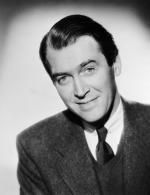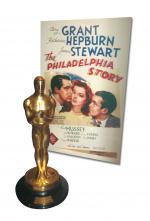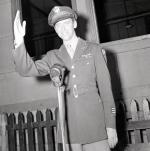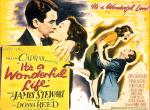![header=[Marker Text] body=[Legendary American actor, born and raised in this town. During his long career, 1932-91, Jimmy Stewart achieved fame on stage, screen, and TV. He won an Academy Award for his role in "The Philadelphia Story." Other films included "Mr. Smith Goes to Washington," "It's a Wonderful Life," and "Harvey." He flew 20 combat missions in World War II; rose to Brigadier General, Air Force Reserve; and received the Presidential Medal of Freedom, 1985. ] sign](http://explorepahistory.com/kora/files/1/10/1-A-266-139-ExplorePAHistory-a0h8a5-a_450.jpg)
Mouse over for marker text
Name:
James Maitland Stewart
Region:
Laurel Highlands/Southern Alleghenies
County:
Indiana
Marker Location:
9th and Philadelphia Sts., Indiana
Dedication Date:
July 2, 1998
Behind the Marker
When Hollywood heard rumblings that actor-turned-California governor Ronald Reagan might actually have eyes on the White House,  Jack Warner, the last surviving brother to run the studio that bore their name, remarked, incredulously, "No. No. You've got it wrong. Jimmy Stewart for president. Ronald Reagan for best friend."
Jack Warner, the last surviving brother to run the studio that bore their name, remarked, incredulously, "No. No. You've got it wrong. Jimmy Stewart for president. Ronald Reagan for best friend."
Such was the image, on screen and off, projected by one of the movies' most-beloved icons. Audiences, in their fantasies, might have yearned for Cary Grant's sophistication, John Wayne's grit, or the grace of Fred Astaire, but they'd follow Jimmy Stewart anywhere. He was one of them, but he was more than that; he was the paragon of who they might be.
Stewart would hem and haw, stutter and stammer, and when he worked himself up, his twang screeched like a tire skid on hot pavement. Bashful? Innocent? Tongue-tied? Awkward? He invented the behavior, lowering his head from his six-foot-four-inch perch to somehow look up at you, before articulating not so much in sentences as through a series of fragments connected by ellipses. Respectful? He never entered a parlor without tipping his hat. Kiss a girl on the first date? He hardly had the nerve to ask her out before the second feature.
Most of all, Jimmy Stewart was the screen's ideal Everyman, unshakably honest, rock-solidly righteous, and willing to stand up for what was decent and good. Lawyer, senator, dreamer, sheriff, flier, band-leader, wildcatter, father, son, voyeur, friend to invisible rabbits - and he became them all on thin strips of celluloid - whatever he played he played with such conviction, the seam between the screen and man disappeared.
"I came to the conclusion," he once said, "that if you could get through a scene…get through an entire movie…and not have the acting show…in other words, go through a scene…if you could do that…then believability sneaks in… And if you get people in the audience believing what they're seeing up there on the screen, then you're in pretty good shape."
"To overcome disbelief," director George Stevens observed, "is the most difficult thing to do in films. And Jimmy, with this extraordinary earnestness he had, just walked in and extinguished disbelief."
Stewart's earnestness wasn't confined to what audiences experienced in the dark. It was as much a part of him as his chromosomes, passed down from his father, and his grandfather before him, community pillars who believed in family, hard work, and serving others. Indeed, in a film culture where some change families with abandon, Stewart married only once, served his country with distinction, and changed the way Hollywood did business. Because, in his mind, they were all the right things to do.
He was born James Maitland Stewart, in 1908, in Indiana, a small Western Pennsylvania town between Pittsburgh and Altoona, where he grew up, the oldest of three children. His parents, Scots-Irish by root, were solidly middle class; his father, Alexander Maitland Stewart, was a Princeton graduate who returned to run the prosperous hardware store that his family founded on Philadelphia Street before the Civil War.
Like his father, Jimmy also went off to Princeton - after prepping at Mercersburg Academy - but unlike his father, his future wasn't back home in Indiana. Still, Stewart always remained close to home. When he won the 1940 Academy Award for Best Actor in The Philadelphia Story, he sent the statuette to his father, who proudly displayed it in his store for the next twenty years.
As a boy, Stewart played sports and was interested in theater, writing plays, and then staging them for the family. He acted in high school and college productions, and though he graduated, in 1932, with an architecture degree, all he wanted to build was characters, so he quickly accepted an offer from his Princeton friend Josh Logan, later one of Broadway's most influential directors, to come to Cape Cod and join the University Players, his fledgling summer stock troupe. There, Stewart met another hopeful thespian - Henry Fonda. The two stars-to-be formed a friendship that survived wildly opposing politics and lasted until Fonda died five decades later.
By the fall, Stewart was playing small parts on Broadway, and by 1934, had risen to featured player. Within a year, he'd taken a screen test, left Broadway for Hollywood, signed on as a contract player at MGM, and moved in with his pal Fonda. The studio wasn't sure what to do with him, though. MGM certainly didn't see him as a leading man - he was too lanky, and he talked funny - so after a series of small roles in big movies, and larger roles in smaller pictures, MGM loaned him to Columbia, where director Frank Capra saw in Stewart an "indefinable personal integrity."
Capra cast him in a pair of movies - You Can't Take It With You in 1938, and Mr. Smith Goes to Washington in 1939 - that honed his screen persona and turned him into a star. His performance in the latter - as the sincere, young senator who launches an improbably successful filibuster against corruption - earned him his first Oscar nomination, and displayed just how far Stewart would go to create a true depiction; to rasp his voice for the film's climactic scene, Stewart had a doctor swab his throat with a mercury solution to inflame his vocal cords.
Over the next two years, he made eight more movies, including The Philadelphia Story, with Cary Grant and Katherine Hepburn, one of the most celebrated romantic comedies ever filmed. Then, nine months before World War II, at the height of his box-office popularity, Stewart, the conservative Republican in a Democratic town, saw the inevitability of World War II and became the first significant Hollywood star to enlist in the military. The brass at MGM was aghast; they wanted Stewart, whom they'd nurtured for five years, safely on screen. Not even studio chief Louis B. Mayer could change Stewart's mind. But the Army rejected Stewart as too thin. Stewart fought back, gained ten pounds, reapplied, and just days after winning his Oscar, passed the physical on the second try.
Before the war ended, he piloted more than twenty bomber missions over France and Germany - including one straight into the heart of Berlin - rose to squadron commander, attained the rank of colonel (later promoted to brigadier general in the reserves) and earned a variety of valorous decorations including the Distinguished Flying Cross and the French Croix de Guerre. When he returned to the movies in 1946, he ordered a clause inserted into his contracts barring studios from publicizing his war record. "He was a press agent's nightmare," said his friend, actor Burgess Meredith, "but a wonderful human being." And about to embark on It's a Wonderful Life.
It was his first movie after five years, and though he felt comfortable again working with Capra, Stewart found himself at personal and professional crossroads. He felt rusty, which is understandable, but, more significantly, compared to what he had experienced as a pilot, movies now seemed trivial to him. Privately, he confided to Capra that he'd finish the picture, and then quit the business. It was co-star Lionel Barrymore who confronted him and changed his mind.
Lionel Barrymore who confronted him and changed his mind.
"I'll always be grateful," Stewart recalled, "because he just came over to me…and everybody on the set could hear ‘cause he always talked loud…and he says to me, ‘Jim, don't you realize you're moving millions of people, shaping their lives? What other profession has that kind of power?" I think he helped me more than anybody."
Of course, Jimmy Stewart stuck around. Had he left after completing the Christmas classic, his legacy as a congenial, light leading man would have been secure, but he'd have deprived audiences of the remarkable transformation that compelled him to start playing against type. Beginning with It's a Wonderful Life, in which he plums the depths of personal despair until an angel shows him the significance of his life, Stewart's work took on a deeper resonance, tempered both by war and maturity. Finally, Jimmy Stewart had the tool he'd been missing: an edge. Coupled with his natural openness, it made him seem even more human, and while he liked to admit that he always played himself "with deference to the character," it made a variety of more complex roles possible.
"With my characters," he remembered, "and I think this was probably the thing I was looking for…unconsciously sort of looked for was a character with vulnerability so that the audience would say, ‘Geez, maybe he's not gonna make it. Maybe he's in real trouble." I tended toward that." Tended? More like defined.
Those qualities made him a natural to build post-war westerns and thrillers around, and, through the 1950s and into the ‘60s, three particular directors - Alfred Hitchcock, Anthony Mann, and John Ford did just that. Under their guidance, a tougher, grittier, more worldly Stewart emerged in movies like The Man Who Knew Too Much, Rear Window, Rope, Vertigo, Winchester 73, Bend in the River, The Man From Laramie, The Far Country, and The Man Who Shot Liberty Valance. Other later memorable Stewart films include Harvey, Anatomy of a Murder, Strategic Air Command, Shenandoah, The Glenn Miller Story, How the West Was Won, and Spirit of St. Louis.
A tougher Stewart emerged off-screen, too. In 1950, recently married and the new step-father of two sons - twin daughters would be born a year later - he became the first major star to break with the traditional system that tied actors, writers, producers and directors to studios. Rather than sign a new long-term contract that would allow a studio to dictate to him, Stewart opted to go freelance, taking smaller up-front salaries in exchange for a percentage of his movies" profits. The tactic made him a millionaire; it also set him free as an actor to plot his own course, changing the way Hollywood did business. Others soon joined him, and by the 1960s, the old studio system on which Hollywood had been built was dead.
Though Stewart's last important screen appearances came in the mid-1960s - about the time so many of the values he seemed to represent were being challenged in the Vietnam War era - he remained a popular presence until his death in 1997. He starred in two TV series, several TV movies and commercials, and was grist for a generation of comedians who loved imitating him. He actively supported his friend Ronald Reagan's campaigns for governor and president, wrote a best-selling book of poetry, and received the Presidential Medal of Freedom, an honorary Academy Award, a Lifetime Achievement Award from the American Film Institute, and 1983 Kennedy Center Honors. Particularly dear to him was the 1995 opening of the Jimmy Stewart Museum in the hometown he managed to keep with him in his heart.
Such was the image, on screen and off, projected by one of the movies' most-beloved icons. Audiences, in their fantasies, might have yearned for Cary Grant's sophistication, John Wayne's grit, or the grace of Fred Astaire, but they'd follow Jimmy Stewart anywhere. He was one of them, but he was more than that; he was the paragon of who they might be.
Stewart would hem and haw, stutter and stammer, and when he worked himself up, his twang screeched like a tire skid on hot pavement. Bashful? Innocent? Tongue-tied? Awkward? He invented the behavior, lowering his head from his six-foot-four-inch perch to somehow look up at you, before articulating not so much in sentences as through a series of fragments connected by ellipses. Respectful? He never entered a parlor without tipping his hat. Kiss a girl on the first date? He hardly had the nerve to ask her out before the second feature.
Most of all, Jimmy Stewart was the screen's ideal Everyman, unshakably honest, rock-solidly righteous, and willing to stand up for what was decent and good. Lawyer, senator, dreamer, sheriff, flier, band-leader, wildcatter, father, son, voyeur, friend to invisible rabbits - and he became them all on thin strips of celluloid - whatever he played he played with such conviction, the seam between the screen and man disappeared.
"I came to the conclusion," he once said, "that if you could get through a scene…get through an entire movie…and not have the acting show…in other words, go through a scene…if you could do that…then believability sneaks in… And if you get people in the audience believing what they're seeing up there on the screen, then you're in pretty good shape."
"To overcome disbelief," director George Stevens observed, "is the most difficult thing to do in films. And Jimmy, with this extraordinary earnestness he had, just walked in and extinguished disbelief."
Stewart's earnestness wasn't confined to what audiences experienced in the dark. It was as much a part of him as his chromosomes, passed down from his father, and his grandfather before him, community pillars who believed in family, hard work, and serving others. Indeed, in a film culture where some change families with abandon, Stewart married only once, served his country with distinction, and changed the way Hollywood did business. Because, in his mind, they were all the right things to do.
He was born James Maitland Stewart, in 1908, in Indiana, a small Western Pennsylvania town between Pittsburgh and Altoona, where he grew up, the oldest of three children. His parents, Scots-Irish by root, were solidly middle class; his father, Alexander Maitland Stewart, was a Princeton graduate who returned to run the prosperous hardware store that his family founded on Philadelphia Street before the Civil War.
Like his father, Jimmy also went off to Princeton - after prepping at Mercersburg Academy - but unlike his father, his future wasn't back home in Indiana. Still, Stewart always remained close to home. When he won the 1940 Academy Award for Best Actor in The Philadelphia Story, he sent the statuette to his father, who proudly displayed it in his store for the next twenty years.
As a boy, Stewart played sports and was interested in theater, writing plays, and then staging them for the family. He acted in high school and college productions, and though he graduated, in 1932, with an architecture degree, all he wanted to build was characters, so he quickly accepted an offer from his Princeton friend Josh Logan, later one of Broadway's most influential directors, to come to Cape Cod and join the University Players, his fledgling summer stock troupe. There, Stewart met another hopeful thespian - Henry Fonda. The two stars-to-be formed a friendship that survived wildly opposing politics and lasted until Fonda died five decades later.
By the fall, Stewart was playing small parts on Broadway, and by 1934, had risen to featured player. Within a year, he'd taken a screen test, left Broadway for Hollywood, signed on as a contract player at MGM, and moved in with his pal Fonda. The studio wasn't sure what to do with him, though. MGM certainly didn't see him as a leading man - he was too lanky, and he talked funny - so after a series of small roles in big movies, and larger roles in smaller pictures, MGM loaned him to Columbia, where director Frank Capra saw in Stewart an "indefinable personal integrity."
Capra cast him in a pair of movies - You Can't Take It With You in 1938, and Mr. Smith Goes to Washington in 1939 - that honed his screen persona and turned him into a star. His performance in the latter - as the sincere, young senator who launches an improbably successful filibuster against corruption - earned him his first Oscar nomination, and displayed just how far Stewart would go to create a true depiction; to rasp his voice for the film's climactic scene, Stewart had a doctor swab his throat with a mercury solution to inflame his vocal cords.
Over the next two years, he made eight more movies, including The Philadelphia Story, with Cary Grant and Katherine Hepburn, one of the most celebrated romantic comedies ever filmed. Then, nine months before World War II, at the height of his box-office popularity, Stewart, the conservative Republican in a Democratic town, saw the inevitability of World War II and became the first significant Hollywood star to enlist in the military. The brass at MGM was aghast; they wanted Stewart, whom they'd nurtured for five years, safely on screen. Not even studio chief Louis B. Mayer could change Stewart's mind. But the Army rejected Stewart as too thin. Stewart fought back, gained ten pounds, reapplied, and just days after winning his Oscar, passed the physical on the second try.
Before the war ended, he piloted more than twenty bomber missions over France and Germany - including one straight into the heart of Berlin - rose to squadron commander, attained the rank of colonel (later promoted to brigadier general in the reserves) and earned a variety of valorous decorations including the Distinguished Flying Cross and the French Croix de Guerre. When he returned to the movies in 1946, he ordered a clause inserted into his contracts barring studios from publicizing his war record. "He was a press agent's nightmare," said his friend, actor Burgess Meredith, "but a wonderful human being." And about to embark on It's a Wonderful Life.
It was his first movie after five years, and though he felt comfortable again working with Capra, Stewart found himself at personal and professional crossroads. He felt rusty, which is understandable, but, more significantly, compared to what he had experienced as a pilot, movies now seemed trivial to him. Privately, he confided to Capra that he'd finish the picture, and then quit the business. It was co-star
"I'll always be grateful," Stewart recalled, "because he just came over to me…and everybody on the set could hear ‘cause he always talked loud…and he says to me, ‘Jim, don't you realize you're moving millions of people, shaping their lives? What other profession has that kind of power?" I think he helped me more than anybody."
Of course, Jimmy Stewart stuck around. Had he left after completing the Christmas classic, his legacy as a congenial, light leading man would have been secure, but he'd have deprived audiences of the remarkable transformation that compelled him to start playing against type. Beginning with It's a Wonderful Life, in which he plums the depths of personal despair until an angel shows him the significance of his life, Stewart's work took on a deeper resonance, tempered both by war and maturity. Finally, Jimmy Stewart had the tool he'd been missing: an edge. Coupled with his natural openness, it made him seem even more human, and while he liked to admit that he always played himself "with deference to the character," it made a variety of more complex roles possible.
"With my characters," he remembered, "and I think this was probably the thing I was looking for…unconsciously sort of looked for was a character with vulnerability so that the audience would say, ‘Geez, maybe he's not gonna make it. Maybe he's in real trouble." I tended toward that." Tended? More like defined.
Those qualities made him a natural to build post-war westerns and thrillers around, and, through the 1950s and into the ‘60s, three particular directors - Alfred Hitchcock, Anthony Mann, and John Ford did just that. Under their guidance, a tougher, grittier, more worldly Stewart emerged in movies like The Man Who Knew Too Much, Rear Window, Rope, Vertigo, Winchester 73, Bend in the River, The Man From Laramie, The Far Country, and The Man Who Shot Liberty Valance. Other later memorable Stewart films include Harvey, Anatomy of a Murder, Strategic Air Command, Shenandoah, The Glenn Miller Story, How the West Was Won, and Spirit of St. Louis.
A tougher Stewart emerged off-screen, too. In 1950, recently married and the new step-father of two sons - twin daughters would be born a year later - he became the first major star to break with the traditional system that tied actors, writers, producers and directors to studios. Rather than sign a new long-term contract that would allow a studio to dictate to him, Stewart opted to go freelance, taking smaller up-front salaries in exchange for a percentage of his movies" profits. The tactic made him a millionaire; it also set him free as an actor to plot his own course, changing the way Hollywood did business. Others soon joined him, and by the 1960s, the old studio system on which Hollywood had been built was dead.
Though Stewart's last important screen appearances came in the mid-1960s - about the time so many of the values he seemed to represent were being challenged in the Vietnam War era - he remained a popular presence until his death in 1997. He starred in two TV series, several TV movies and commercials, and was grist for a generation of comedians who loved imitating him. He actively supported his friend Ronald Reagan's campaigns for governor and president, wrote a best-selling book of poetry, and received the Presidential Medal of Freedom, an honorary Academy Award, a Lifetime Achievement Award from the American Film Institute, and 1983 Kennedy Center Honors. Particularly dear to him was the 1995 opening of the Jimmy Stewart Museum in the hometown he managed to keep with him in his heart.










